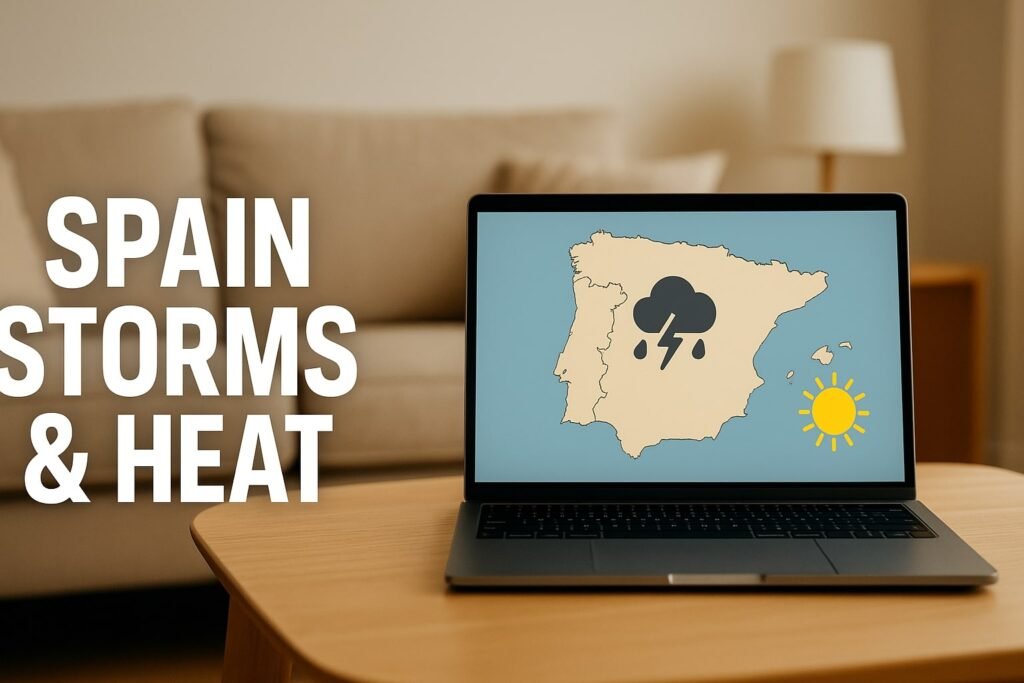Spain is dealing with a rare double threat this weekend. In the north and east, cities like Barcelona and Girona are under red alert for flash floods and violent thunderstorms. In the south, places like Seville and Córdoba are sweating through extreme heat that just won’t ease up. This isn’t just regular summer turbulence. What’s unfolding across Spain is the result of a rare July weather pattern called a DANA, or “Depresión Aislada en Niveles Altos,” which roughly translates to a cold drop. While these cut-off lows are more common in the autumn months, the one hammering Spain now has arrived early, fueled by an overheated Mediterranean and unstable air trapped over land.
Catalonia has been hit the hardest so far. Hundreds of emergency calls were logged in a matter of hours as torrential rain flooded streets, swamped tunnels and overwhelmed the regional transport network. Barcelona’s local train service ground to a halt, major roads were impassable and several flights were diverted. Two people remain missing in the province after a sudden surge in the Foix River swept through parts of Cubelles. Search teams with helicopters and divers have been working through the night. Meanwhile, Aragón and Navarra have been placed under amber alerts with risk of large hail and isolated wind bursts as the storm cells continue to rotate and drift slowly east.
This sharp contrast across Spain, with heat alerts in the south and flood warnings in the northeast, comes down to a clash in air masses. The DANA is pulling cooler air southward from the upper atmosphere, while the ground-level air remains saturated with moisture. At the same time, the southern half of Spain is still baking under dry skies and intense sun. Temperatures have hovered between 38 and 43 degrees Celsius in parts of Andalusia, Extremadura and Castilla-La Mancha. Though some cooling has arrived in western areas, it’s far from enough to knock out the heatwave entirely. In fact, more highs over 40 degrees are forecast through early next week.
For many in Spain, this weekend has been a shock to the system. One day, people were ducking for shade from oppressive sunlight, the next they were stuck on flooded highways or watching rivers rise with frightening speed. Residents across Catalonia received emergency phone alerts Saturday afternoon, warning them to stay off roads and keep away from riverbanks. The intensity of the rain overwhelmed even hardened locals used to autumn storms. At one point, rainfall rates hit 60 litres per square meter in less than an hour. That’s more than a month’s worth of rain for this part of Spain during July.
The military’s emergency unit, known as the UME, has been deployed to help manage the chaos. Crews have focused on clearing roads, rescuing stranded drivers and reinforcing infrastructure threatened by surging water. In some areas, power outages have been reported due to lightning and water damage. Authorities are urging residents to monitor local weather apps and avoid any unnecessary travel until the worst of the system moves offshore.
According to meteorologists, the DANA is expected to drift eastward into the Balearic Sea by late Sunday or early Monday. Once it clears, more stable and hot weather will likely return. However, the quick arrival of this storm and its strength has reignited climate concerns. Experts note that the Mediterranean is running 2 to 3 degrees Celsius warmer than average for this time of year. That means the atmosphere has more fuel to power sudden, high-intensity storms like this one. In fact, four of the five most intense DANA events recorded in Spain since 1980 have occurred in just the past six years.
While northern Spain grapples with flooding, the central and southern parts of the country are dealing with the lingering impacts of a severe heatwave. Hospitals in cities like Seville and Granada have seen a spike in heat-related emergencies. Farmers in the Andalusian countryside are growing increasingly worried about their crops, particularly olives, which are sensitive to extreme temperature swings during key development phases. The dual risk of heat and sudden floods has placed pressure on emergency services, civil protection units and even the power grid in some regions.
Looking ahead, the short-range forecast suggests calmer days are in sight. By Tuesday and Wednesday, most of Spain should return to clear skies and temperatures in the mid-30s, although inland areas could see heat creep back toward 40 again. However, there’s a weak Atlantic disturbance brewing that might reach the northwest coast by late week. That could bring more clouds and possible showers to Galicia and nearby provinces. There’s also a chance of Saharan dust returning to the skies over the southeast, which often happens after these stormy bursts.
Travellers in Spain this week are advised to remain flexible. If you’re in Catalonia, Aragón or Navarra, stay alert for changing flood warnings and pay close attention to local updates from AEMET, Spain’s official meteorological agency. If you’re heading south or currently there, stay hydrated and avoid peak sun hours. The UV index is expected to stay near 10, which can cause sunburn in just minutes.
The big story behind this weather event isn’t just about local chaos. It’s a reminder that Spain is caught between climate extremes. The same conditions that bring intense heatwaves also set the stage for flash floods. A warming Mediterranean, shifting jet streams and record-breaking ocean temperatures all point toward a future with more volatile summers. This weekend’s storm hit fast, hit hard and exposed just how fragile the balance can be when hot, humid and unstable air meet above such a diverse country.
Here on CycloneRadar, we’ll keep tracking the patterns, the pressure drops, the heat domes and the flash floods. Because the weather in Spain is no longer just about sunshine and sangria. It’s about staying alert, staying safe and understanding what’s brewing in the sky above us.


